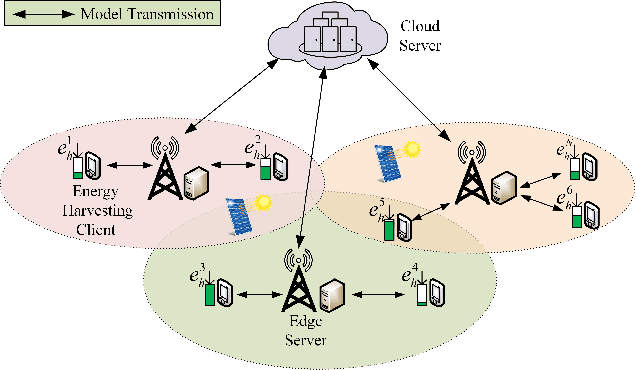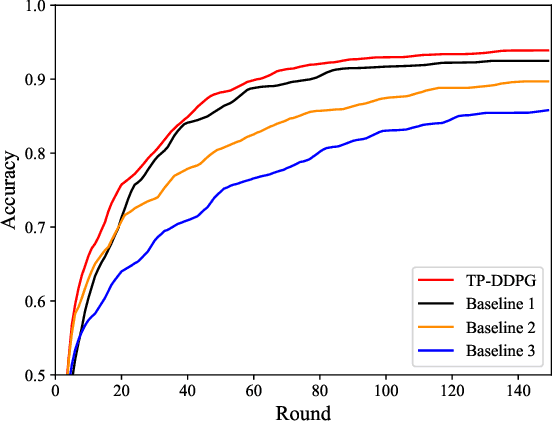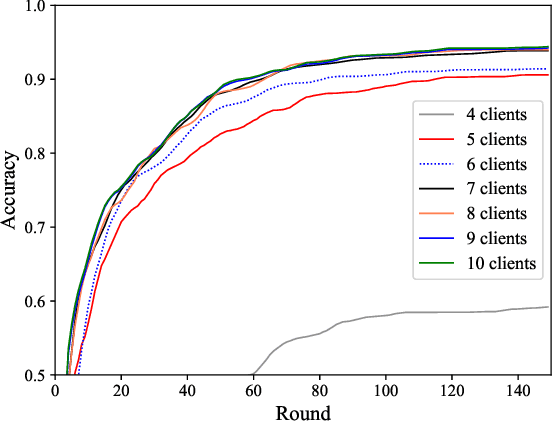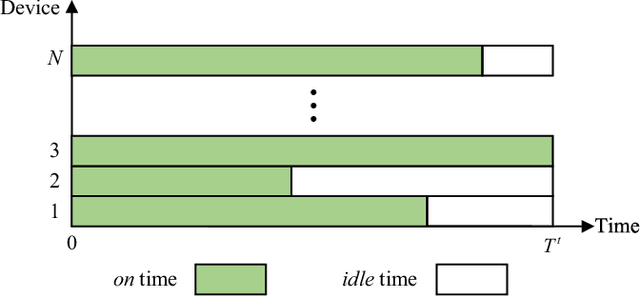Shugong Xu
Fellow, IEEE
C2S-AE: CSI to Sensing enabled by an Auto-Encoder-based Framework
Mar 02, 2025Abstract:Next-generation mobile networks are set to utilize integrated sensing and communication (ISAC) as a critical technology, providing significant support for sectors like the industrial Internet of Things (IIoT), extended reality (XR), and smart home applications. A key challenge in ISAC implementation is the extraction of sensing parameters from radio signals, a task that conventional methods struggle to achieve due to the complexity of acquiring sensing channel data. In this paper, we introduce a novel auto-encoder (AE)-based framework to acquire sensing information using channel state information (CSI). Specifically, our framework, termed C2S (CSI to sensing)-AE, learns the relationship between CSI and the delay power spectrum (DPS), from which the range information can be readily accessed. To validate our framework's performance, we conducted measurements of DPS and CSI in real-world scenarios and introduced the dataset 'SHU7'. Our extensive experiments demonstrate that the framework excels in C2S extrapolation, surpassing existing methods in terms of accuracy for both delay and signal strength of individual paths. This innovative approach holds the potential to greatly enhance sensing capabilities in future mobile networks, paving the way for more robust and versatile ISAC applications.
MTCA: Multi-Task Channel Analysis for Wireless Communication
Feb 26, 2025Abstract:In modern wireless communication systems, the effective processing of Channel State Information (CSI) is crucial for enhancing communication quality and reliability. However, current methods often handle different tasks in isolation, thereby neglecting the synergies among various tasks and leading to extract CSI features inadequately for subsequent analysis. To address these limitations, this paper introduces a novel Multi-Task Channel Analysis framework named MTCA, aimed at improving the performance of wireless communication even sensing. MTCA is designed to handle four critical tasks, including channel prediction, antenna-domain channel extrapolation, channel identification, and scenario classification. Experiments conducted on a multi-scenario, multi-antenna dataset tailored for UAV-based communications demonstrate that the proposed MTCA exhibits superior comprehension of CSI, achieving enhanced performance across all evaluated tasks. Notably, MTCA reached 100% prediction accuracy in channel identification and scenario classification. Compared to the previous state-of-the-art methods, MTCA improved channel prediction performance by 20.1% and antenna-domain extrapolation performance by 54.5%.
A MIMO Wireless Channel Foundation Model via CIR-CSI Consistency
Feb 17, 2025Abstract:In the field of artificial intelligence, self-supervised learning has demonstrated superior generalization capabilities by leveraging large-scale unlabeled datasets for pretraining, which is especially critical for wireless communication models to adapt to a variety of scenarios. This paper innovatively treats Channel State Information (CSI) and Channel Impulse Response (CIR) as naturally aligned multi-modal data and proposes the first MIMO wireless channel foundation model, named CSI-CLIP. By effectively capturing the joint representations of both CIR and CSI, CSI-CLIP exhibits remarkable adaptability across scenarios and robust feature extraction capabilities. Experimental results show that in positioning task, CSI-CLIP reduces the mean error distance by 22%; in beam management task, it increases accuracy by 1% compared to traditional supervised methods, as well as in the channel identification task. These improvements not only highlight the potential and value of CSI-CLIP in integrating sensing and communication but also demonstrate its significant advantages over existing techniques. Moreover, viewing CSI and CIR as multi-modal pairs and contrastive learning for wireless channel foundation model open up new research directions in the domain of MIMO wireless communications.
AI-driven Wireless Positioning: Fundamentals, Standards, State-of-the-art, and Challenges
Jan 24, 2025



Abstract:Wireless positioning technologies hold significant value for applications in autonomous driving, extended reality (XR), unmanned aerial vehicles (UAVs), and more. With the advancement of artificial intelligence (AI), leveraging AI to enhance positioning accuracy and robustness has emerged as a field full of potential. Driven by the requirements and functionalities defined in the 3rd Generation Partnership Project (3GPP) standards, AI/machine learning (ML)-based positioning is becoming a key technology to overcome the limitations of traditional methods. This paper begins with an introduction to the fundamentals of AI and wireless positioning, covering AI models, algorithms, positioning applications, emerging wireless technologies, and the basics of positioning techniques. Subsequently, focusing on standardization progress, we provide a comprehensive review of the evolution of 3GPP positioning standards, with an emphasis on the integration of AI/ML technologies in recent and upcoming releases. Based on the AI/ML-assisted positioning and direct AI/ML positioning schemes outlined in the standards, we conduct an in-depth investigation of related research. we focus on state-of-the-art (SOTA) research in AI-based line-of-sight (LOS)/non-line-of-sight (NLOS) detection, time of arrival (TOA)/time difference of arrival (TDOA) estimation, and angle estimation techniques. For Direct AI/ML Positioning, we explore SOTA advancements in fingerprint-based positioning, knowledge-assisted AI positioning, and channel charting-based positioning. Furthermore, we introduce publicly available datasets for wireless positioning and conclude by summarizing the challenges and opportunities of AI-driven wireless positioning.
Energy Optimization of Multi-task DNN Inference in MEC-assisted XR Devices: A Lyapunov-Guided Reinforcement Learning Approach
Jan 05, 2025Abstract:Extended reality (XR), blending virtual and real worlds, is a key application of future networks. While AI advancements enhance XR capabilities, they also impose significant computational and energy challenges on lightweight XR devices. In this paper, we developed a distributed queue model for multi-task DNN inference, addressing issues of resource competition and queue coupling. In response to the challenges posed by the high energy consumption and limited resources of XR devices, we designed a dual time-scale joint optimization strategy for model partitioning and resource allocation, formulated as a bi-level optimization problem. This strategy aims to minimize the total energy consumption of XR devices while ensuring queue stability and adhering to computational and communication resource constraints. To tackle this problem, we devised a Lyapunov-guided Proximal Policy Optimization algorithm, named LyaPPO. Numerical results demonstrate that the LyaPPO algorithm outperforms the baselines, achieving energy conservation of 24.79% to 46.14% under varying resource capacities. Specifically, the proposed algorithm reduces the energy consumption of XR devices by 24.29% to 56.62% compared to baseline algorithms.
SANDWICH: Towards an Offline, Differentiable, Fully-Trainable Wireless Neural Ray-Tracing Surrogate
Nov 13, 2024Abstract:Wireless ray-tracing (RT) is emerging as a key tool for three-dimensional (3D) wireless channel modeling, driven by advances in graphical rendering. Current approaches struggle to accurately model beyond 5G (B5G) network signaling, which often operates at higher frequencies and is more susceptible to environmental conditions and changes. Existing online learning solutions require real-time environmental supervision during training, which is both costly and incompatible with GPU-based processing. In response, we propose a novel approach that redefines ray trajectory generation as a sequential decision-making problem, leveraging generative models to jointly learn the optical, physical, and signal properties within each designated environment. Our work introduces the Scene-Aware Neural Decision Wireless Channel Raytracing Hierarchy (SANDWICH), an innovative offline, fully differentiable approach that can be trained entirely on GPUs. SANDWICH offers superior performance compared to existing online learning methods, outperforms the baseline by 4e^-2 radian in RT accuracy, and only fades 0.5 dB away from toplined channel gain estimation.
LinFormer: A Linear-based Lightweight Transformer Architecture For Time-Aware MIMO Channel Prediction
Oct 28, 2024



Abstract:The emergence of 6th generation (6G) mobile networks brings new challenges in supporting high-mobility communications, particularly in addressing the issue of channel aging. While existing channel prediction methods offer improved accuracy at the expense of increased computational complexity, limiting their practical application in mobile networks. To address these challenges, we present LinFormer, an innovative channel prediction framework based on a scalable, all-linear, encoder-only Transformer model. Our approach, inspired by natural language processing (NLP) models such as BERT, adapts an encoder-only architecture specifically for channel prediction tasks. We propose replacing the computationally intensive attention mechanism commonly used in Transformers with a time-aware multi-layer perceptron (TMLP), significantly reducing computational demands. The inherent time awareness of TMLP module makes it particularly suitable for channel prediction tasks. We enhance LinFormer's training process by employing a weighted mean squared error loss (WMSELoss) function and data augmentation techniques, leveraging larger, readily available communication datasets. Our approach achieves a substantial reduction in computational complexity while maintaining high prediction accuracy, making it more suitable for deployment in cost-effective base stations (BS). Comprehensive experiments using both simulated and measured data demonstrate that LinFormer outperforms existing methods across various mobility scenarios, offering a promising solution for future wireless communication systems.
TLD: A Vehicle Tail Light signal Dataset and Benchmark
Sep 04, 2024



Abstract:Understanding other drivers' intentions is crucial for safe driving. The role of taillights in conveying these intentions is underemphasized in current autonomous driving systems. Accurately identifying taillight signals is essential for predicting vehicle behavior and preventing collisions. Open-source taillight datasets are scarce, often small and inconsistently annotated. To address this gap, we introduce a new large-scale taillight dataset called TLD. Sourced globally, our dataset covers diverse traffic scenarios. To our knowledge, TLD is the first dataset to separately annotate brake lights and turn signals in real driving scenarios. We collected 17.78 hours of driving videos from the internet. This dataset consists of 152k labeled image frames sampled at a rate of 2 Hz, along with 1.5 million unlabeled frames interspersed throughout. Additionally, we have developed a two-stage vehicle light detection model consisting of two primary modules: a vehicle detector and a taillight classifier. Initially, YOLOv10 and DeepSORT captured consecutive vehicle images over time. Subsequently, the two classifiers work simultaneously to determine the states of the brake lights and turn signals. A post-processing procedure is then used to eliminate noise caused by misidentifications and provide the taillight states of the vehicle within a given time frame. Our method shows exceptional performance on our dataset, establishing a benchmark for vehicle taillight detection. The dataset is available at https://huggingface.co/datasets/ChaiJohn/TLD/tree/main
A Learnable Color Correction Matrix for RAW Reconstruction
Sep 04, 2024



Abstract:Autonomous driving algorithms usually employ sRGB images as model input due to their compatibility with the human visual system. However, visually pleasing sRGB images are possibly sub-optimal for downstream tasks when compared to RAW images. The availability of RAW images is constrained by the difficulties in collecting real-world driving data and the associated challenges of annotation. To address this limitation and support research in RAW-domain driving perception, we design a novel and ultra-lightweight RAW reconstruction method. The proposed model introduces a learnable color correction matrix (CCM), which uses only a single convolutional layer to approximate the complex inverse image signal processor (ISP). Experimental results demonstrate that simulated RAW (simRAW) images generated by our method provide performance improvements equivalent to those produced by more complex inverse ISP methods when pretraining RAW-domain object detectors, which highlights the effectiveness and practicality of our approach.
Towards Dynamic Resource Allocation and Client Scheduling in Hierarchical Federated Learning: A Two-Phase Deep Reinforcement Learning Approach
Jun 21, 2024



Abstract:Federated learning (FL) is a viable technique to train a shared machine learning model without sharing data. Hierarchical FL (HFL) system has yet to be studied regrading its multiple levels of energy, computation, communication, and client scheduling, especially when it comes to clients relying on energy harvesting to power their operations. This paper presents a new two-phase deep deterministic policy gradient (DDPG) framework, referred to as ``TP-DDPG'', to balance online the learning delay and model accuracy of an FL process in an energy harvesting-powered HFL system. The key idea is that we divide optimization decisions into two groups, and employ DDPG to learn one group in the first phase, while interpreting the other group as part of the environment to provide rewards for training the DDPG in the second phase. Specifically, the DDPG learns the selection of participating clients, and their CPU configurations and the transmission powers. A new straggler-aware client association and bandwidth allocation (SCABA) algorithm efficiently optimizes the other decisions and evaluates the reward for the DDPG. Experiments demonstrate that with substantially reduced number of learnable parameters, the TP-DDPG can quickly converge to effective polices that can shorten the training time of HFL by 39.4% compared to its benchmarks, when the required test accuracy of HFL is 0.9.
 Add to Chrome
Add to Chrome Add to Firefox
Add to Firefox Add to Edge
Add to Edge